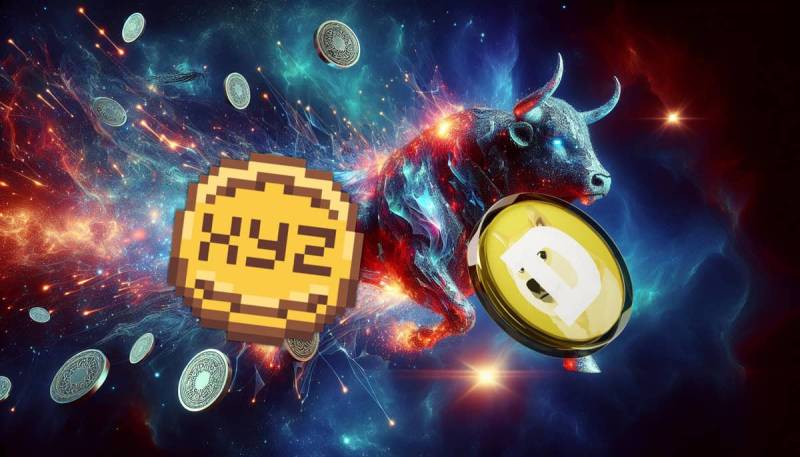 |
|
 |
|
 |
|
 |
|
 |
|
 |
|
 |
|
 |
|
 |
|
 |
|
 |
|
 |
|
 |
|
 |
|
 |
|
Cryptocurrency News Articles
The Hashrate of Bitcoin Has Been Declining for a Few Weeks
Feb 21, 2025 at 06:49 pm
The global Bitcoin hashrate is an estimate that measures the computing power allocated overall in the world in Bitcoin mining.

The hashrate of Bitcoin has been declining for a few weeks. Taking as a reference the seven-day moving average calculated by Hashrate Index, after reaching the new all-time high at 850 Eh/s on February 8th, just a few days later it had already returned to 812 Eh/s.
A couple of days ago it had returned to 841 Eh/s, but today it is back to 816.
The records of Bitcoin’s hashrate
The global Bitcoin hashrate is an estimate that measures the computing power allocated overall in the world in Bitcoin mining.
It is measured in ExaHash per second (Eh/s), that is, in billions of billions of hashes per second. Hashes are the strings of text that validate the blocks, and that the miners randomly extract in search of the single string that validates a single block.
With the current level of difficulty, it is necessary to randomly extract billions upon billions of hashes every second, worldwide, in order to identify approximately every 10 minutes the one that confirms a new block.
A year ago, the global hashrate of Bitcoin was just over 550 Eh/s, and at the beginning of October 2024, it had risen to 625. With the bull run in November, it then rose for the first time in history above 700 Eh/s, and in December, for the first time, it also rose above 800.
The all-time high was reached at the beginning of February 2025, while the current levels are still in line with those of early January. In short, there is absolutely nothing to worry about.
The difficult market conditions
The fact that for Bitcoin this situation is not at all concerning, does not mean, however, that the same thing must also apply to the miners.
Indeed, for smaller miners, and for those who have to bear higher costs for purchasing electricity, the current market conditions are difficult.
Taking as a reference the Bitcoin Mining Profitability from BitInfoCharts, which estimates the profitability of BTC mining, the current levels are definitely low.
A year ago they were $0.078 per THash/s, but by May 2024 they had already fallen below $0.05.
With the bullrun at the end of 2024, they had almost returned to $0.07, but starting from the end of December, the growth trend reversed.
It must be said, however, that even though the current values have fallen back below $0.06, they are still above $0.055, which is significantly higher than those in October. Just consider that in September they even fell below $0.04, marking practically the all-time lows.
The cost of mining
The main cost that miners have to face is related to electricity. As is well known, Bitcoin mining consumes a lot of electricity because it is a competition where the winner is the one with the most hashrate. In fact, miners are incentivized to use the maximum possible hashrate. However, with equal efficiency, more hashrate also necessarily means higher electricity consumption.
The increases or decreases in electricity consumption for Bitcoin mining primarily depend on two factors: the difficulty and the efficiency of the machines.
The first is directly correlated with electricity consumption, while the second is inversely correlated.
However, while the difficulty varies every two weeks, the efficiency of the machines improves only over time, with significantly longer timeframes. Thus, in the short term, only the difficulty really matters.
Currently, the difficulty, after the increase on February 9th, is at its peak, but it is likely that at the next update (expected over the weekend) it will decrease a bit.
Just think that a year ago it was 81.7 T, and that even in October it was below 95 T. Now, however, it is at 114 T, and at these levels several miners struggle to cover the costs, thus having to shut down the less efficient machines.
Energy consumption
It should also be highlighted that the cost of electricity is not the same for everyone.
Those who can access large amounts of low-cost electricity can also use less efficient machines, while those who are forced to pay more for electricity at this time are compelled to turn off the less efficient machines, having to use only the latest generation, more efficient ones.
It should also be remembered, however, that the Bitcoin protocol does not impose at all, and in any way, a certain energy consumption. This consumption is solely and exclusively the result of independent and arbitrary decisions by the miners, even if they are in fact incentivized to use as much hashrate as possible, and therefore to consume as much electricity as possible.
In a situation
Disclaimer:info@kdj.com
The information provided is not trading advice. kdj.com does not assume any responsibility for any investments made based on the information provided in this article. Cryptocurrencies are highly volatile and it is highly recommended that you invest with caution after thorough research!
If you believe that the content used on this website infringes your copyright, please contact us immediately (info@kdj.com) and we will delete it promptly.
-

-

- Dogecoin (DOGE) Price Action Hints at an Impending Breakout as Whales Accumulate
- Feb 22, 2025 at 12:50 pm
- Dogecoin's (DOGE) roller coaster ride continues, with prices dropping 3% over the past week. Instead of triggering mass sell-offs, this dip has emboldened large investors who see a buying opportunity.
-

-

- Binance Coin (BNB) Struggles to Maintain Momentum, While a New Layer-1 Blockchain, Coldware (COLD), Gains Market Share
- Feb 22, 2025 at 12:50 pm
- Binance Coin (BNB) is struggling to maintain momentum, hovering below the $700 resistance level, while a new Layer-1 blockchain, Coldware (COLD), is rapidly gaining traction among high-net-worth (HNW) investors.
-

-

-

-

-























































